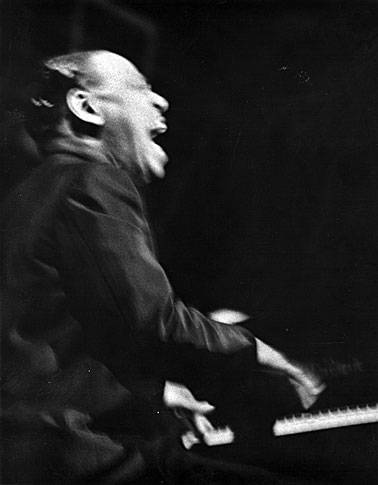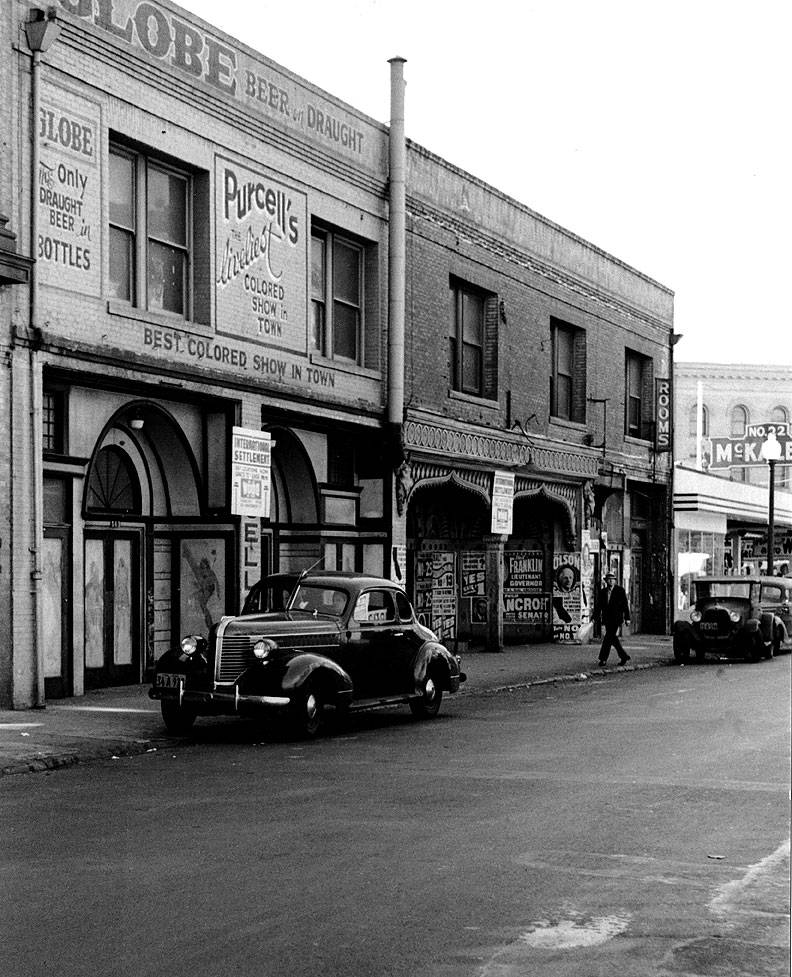BLACK JAZZ CLUBS BEFORE WWII: Difference between revisions
(added blockquotes and changed navigation for deleted page) |
No edit summary |
||
| (2 intermediate revisions by the same user not shown) | |||
| Line 1: | Line 1: | ||
'''<font face = arial light> <font color = maroon> <font size = 3>Unfinished History</font></font> </font>''' | '''<font face = arial light> <font color = maroon> <font size = 3>Unfinished History</font></font> </font>''' | ||
<iframe src="https://archive.org/embed/0633_Gould_can_5423_4_11_34_02_10" width="640" height="480" frameborder="0" webkitallowfullscreen="true" mozallowfullscreen="true" allowfullscreen></iframe> | |||
'''Interior of Black dance hall, 1914.''' Wonderful clip of early African American Dance, with many called variations as well as the "Texas Tommy Swing dance" as it was called and appeared in print in 1910. The most famous song for this dance was called King Chanticleer. for more information read Tom Stoddards book ''Jazz on the Barbary Coast''. | |||
''Video: [https://archive.org/details/0633_Gould_can_5423_4_11_34_02_10 Prelinger Archive]'' | |||
<iframe src="https://archive.org/embed/0633_Gould_can_5423_3_11_32_33_23" width="640" height="480" frameborder="0" webkitallowfullscreen="true" mozallowfullscreen="true" allowfullscreen></iframe> | |||
'''More dancing, this time on the street, perhaps somewhere in North Beach near or on the Barbary Coast, 1914.''' | |||
''Video: [https://archive.org/details/0633_Gould_can_5423_3_11_32_33_23 Prelinger Archive]'' | |||
[[Image:Cab-calloway.jpg]] | [[Image:Cab-calloway.jpg]] | ||
| Line 8: | Line 20: | ||
During the roaring prohibition-era 1920s, San Francisco's Tenderloin was a bustling center for all sorts of legal and illegal activities. Always an open vice town, San Francisco was said to be 85% "wet" during prohibition, and the major destination of west coast-bound contraband liquor shipments. | During the roaring prohibition-era 1920s, San Francisco's Tenderloin was a bustling center for all sorts of legal and illegal activities. Always an open vice town, San Francisco was said to be 85% "wet" during prohibition, and the major destination of west coast-bound contraband liquor shipments. | ||
[[Image:Purcells-1938-Barbary-Coast-via-Jimmie-Shein.jpg]] | |||
'''Purcells on Pacific Avenue in the Barbary Coast, c. 1938.''' | |||
''Photo: © Shein & Shein'' | |||
Black-owned jazz clubs (Purcell's on the Barbary Coast, and Lester Mapp's place on Townsend) became the center of illegal consumption, and all sorts of off-limits behavior such as racial intermingling. Douglas Daniels in ''Pioneer Urbanites'' suggests that San Francisco is the home of "jazz," emerging from the ragtime scene which had its most authentic expression in black dance clubs of the WWI era: | Black-owned jazz clubs (Purcell's on the Barbary Coast, and Lester Mapp's place on Townsend) became the center of illegal consumption, and all sorts of off-limits behavior such as racial intermingling. Douglas Daniels in ''Pioneer Urbanites'' suggests that San Francisco is the home of "jazz," emerging from the ragtime scene which had its most authentic expression in black dance clubs of the WWI era: | ||
| Line 26: | Line 44: | ||
[[Wesley Johnson Senior |Prev. Document]] [[Terry Francois |Next Document]] | [[Wesley Johnson Senior |Prev. Document]] [[Terry Francois |Next Document]] | ||
[[category:African-American]] [[category:Music]] [[category:1910s]] [[category:1920s]] [[category:1930s]] [[category:media]] [[category:Tenderloin]] [[category:North Beach]] [[category:SOMA]] | [[category:African-American]] [[category:Music]] [[category:1910s]] [[category:1920s]] [[category:1930s]] [[category:media]] [[category:Tenderloin]] [[category:North Beach]] [[category:SOMA]] [[category:Dance]] | ||
Latest revision as of 21:48, 21 December 2021
Unfinished History
<iframe src="https://archive.org/embed/0633_Gould_can_5423_4_11_34_02_10" width="640" height="480" frameborder="0" webkitallowfullscreen="true" mozallowfullscreen="true" allowfullscreen></iframe>
Interior of Black dance hall, 1914. Wonderful clip of early African American Dance, with many called variations as well as the "Texas Tommy Swing dance" as it was called and appeared in print in 1910. The most famous song for this dance was called King Chanticleer. for more information read Tom Stoddards book Jazz on the Barbary Coast.
Video: Prelinger Archive
<iframe src="https://archive.org/embed/0633_Gould_can_5423_3_11_32_33_23" width="640" height="480" frameborder="0" webkitallowfullscreen="true" mozallowfullscreen="true" allowfullscreen></iframe>
More dancing, this time on the street, perhaps somewhere in North Beach near or on the Barbary Coast, 1914.
Video: Prelinger Archive
Earl Hines in San Francisco, n.d.
Photo: Kurt Bank
During the roaring prohibition-era 1920s, San Francisco's Tenderloin was a bustling center for all sorts of legal and illegal activities. Always an open vice town, San Francisco was said to be 85% "wet" during prohibition, and the major destination of west coast-bound contraband liquor shipments.
Purcells on Pacific Avenue in the Barbary Coast, c. 1938.
Photo: © Shein & Shein
Black-owned jazz clubs (Purcell's on the Barbary Coast, and Lester Mapp's place on Townsend) became the center of illegal consumption, and all sorts of off-limits behavior such as racial intermingling. Douglas Daniels in Pioneer Urbanites suggests that San Francisco is the home of "jazz," emerging from the ragtime scene which had its most authentic expression in black dance clubs of the WWI era:
Played properly, it impelled people of all social classes and ethnic backgrounds to mingle in cafes and saloons and to delight in the African rhythms by dancing to and singing the songs... Although it possessed European elements, this American urban music was often written and played best by Afro-Americans because of their command of the poly-rhythms that were essential to the music... The dances, too, startled many Americans, who thought the hip movement that is essential to African and Afro-American dance was licentious...
The presence of women in the resorts (as the clubs were known) was another appalling aspect of urban culture. The new freedom of American women recalled that of San Francisco adventuresses of an earlier era. During and after the first World War, in SF and other cities, young unmarried women and housewives frequented cafes and night clubs where they smoked, drank, danced, and flirted with attentive males... For reformist ministers, women's club leaders, and progressives, this represented a threat to home and society. They sought to prohibit afternoon dancing to deny women their "questionable pleasures," as the Examiner referred to them. (Jan. 14, 1917).
An article in the Spokesman in 1933 described night life in the Tenderloin along Market Street:
Altogether the street is like the fairway of an enormous circus or carnival. Colors, lights, crowds, music, candy, hawkers, ballyhoo--everything is there but the elephants and the sawdust... Hindoos, Japanese, Black men with wide shoulders, slim hips, loose relaxed gait, noisy Jews, Swedes, Spaniards, fat Chinese, lean Englishmen...
This quote demonstrates a certain unique openness in San Francisco, but it was in this same period, the 1930s, that white racist anxiety increased. Police refused to issue a permit for an interracial night club on Fillmore in the mid-30s and several incidents occurred in which white policemen arrested interracial couples for violating California's strict laws against miscegenation. In one case, two white women and a black man in a car were arrested, even over the protests of one of the women that the man was her chauffeur. This heightened racial oppression set a more hostile stage for the dramatic influx of southern blacks in the early 1940s, seeking wartime employment.
--Chris Carlsson


